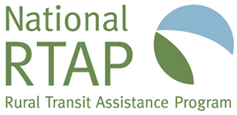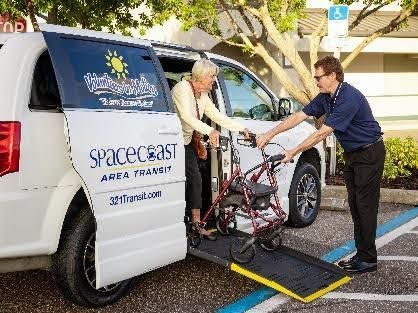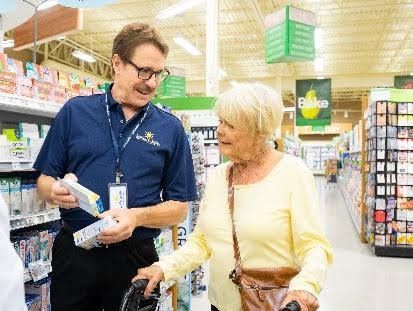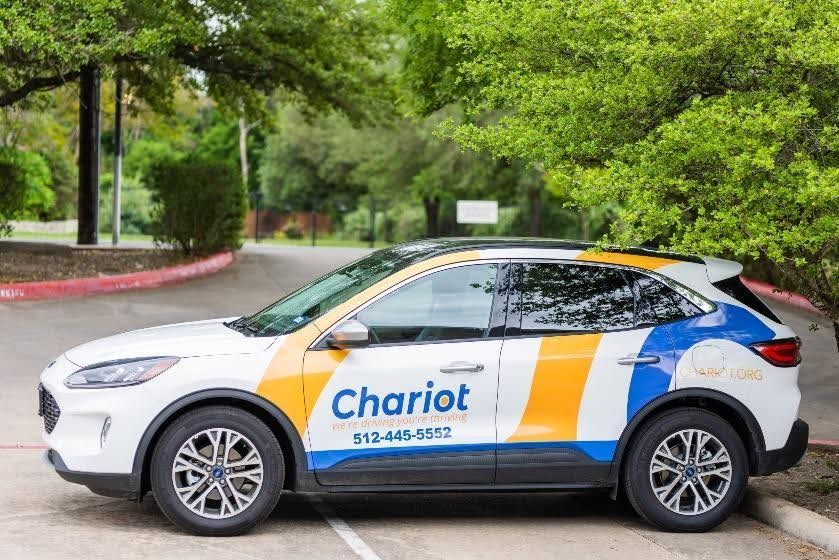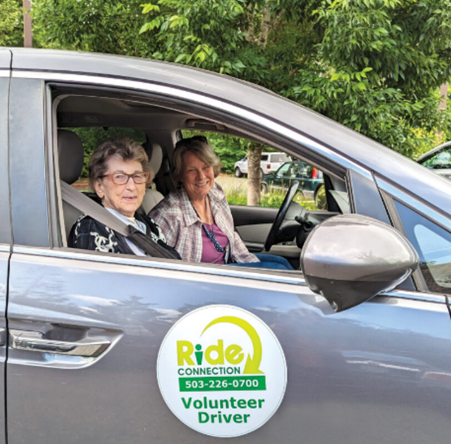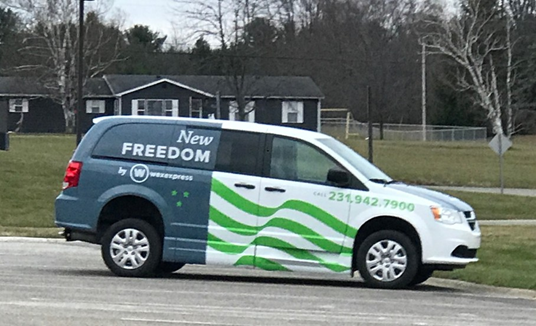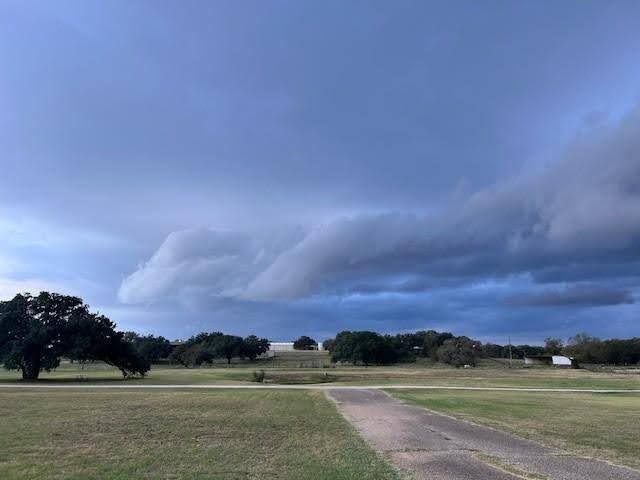Section 5 – Day-to-Day Operations
Photo credit: Space Coast Transit/Volunteers in Motion
This section of the Toolkit contains guidelines on the types of policies and procedures that should be considered for the day-to-day operations of a volunteer driver program. For the purposes of this Toolkit, the term “Operations” includes policies and processes related to scheduling rides, management of vehicles (including private vehicles) used to provide passenger transportation services, maintenance of vehicles and equipment, and incidents, accidents, and collisions.
While this section of the Toolkit focuses on the day-to-day operations of a volunteer driver program, the interaction between these operational functions and the guidance and information provided in other sections of this Toolkit are meant to work together.
This section covers the following key aspects related to day-to-day operations:
Scheduling
The scheduling of trips is a critical component of the day-to-day operations of a volunteer driver program, and the process can vary from one program to another based on the number of available drivers, use of technology, and other factors. Some considerations include:
How far in advance should requests be submitted?
Volunteer driver programs need sufficient time to match the requested ride with an available and appropriate volunteer driver. Therefore, most programs require ride requests to be submitted at least two to three days in advance. This would include requests for both one-way and round trips.
Standing order or reoccurring trips may be scheduled for individual riders with weekly or monthly appointments. However, programs may want to establish a maximum lead time for trip reservations. When reservations are made too far in advance, riders may forget and this can lead to no shows. The program may require that the rider confirm each trip in advance.
Some volunteer driver programs, like Ride Connection in Portland, Oregon, offer a variety of transportation options and ask that riders make requests at least four days in advance. This gives the program’s travel option counselors time to match individuals with appropriate services. Read more about Ride Connection in
Section 7: Case Studies.
How should volunteer preferences be taken into consideration?
Although changes to driver schedules will be ongoing, through the recruitment process volunteers should be asked what days of the week they would be available. Other preferences can be taken into account, such as any geographic limitations and length of trip they are willing to provide. Some riders may need greater assistance than some volunteers can provide.
Some volunteers may prefer to transport people similar to their age or of the same gender, and while it is very important that driver preferences be taken into account, they must be balanced with the need to ensure that all rider needs are met. See
Section 7: Case Studies/Part Three – Lessons Learned
of this Toolkit for additional insight on how clear guidelines and expectations for volunteer drivers are necessary to ensure smooth day-to-day operations and high-quality service.
Care should be taken to not overwork volunteers.
SAINT
Volunteer Program:
The volunteer driver application and interview should include questions about the volunteer’s preferences.
Those preferences must be readily available to the scheduler.
Read more about
SAINT in
Section 7: Case Studies.
What type of technology should be used to schedule trips?
The use of technology is often dictated by the size of the volunteer driver program. Smaller organizations with 20 or less daily trips often use simple spreadsheets.
Larger programs may use software that allow riders to schedule through a portal and volunteers to have access to a database through which they can accept trip requests (in addition to through phone calls).
Section 7: Case Studies/Part Two – Common Themes/Software Considerations of this Toolkit contains additional insight on how some volunteer driver programs have been able to use various software technologies to enhance or improve service delivery and day-to-day operations.
Is there a limit on how many trips a rider can schedule?
Most volunteer driver programs have a limit on how many rides a client can request within a certain timeframe. For instance,
Neighbor Ride in Howard County, Maryland notes that passengers are eligible for a maximum of 12 rides per month.
Is there a maximum one-way distance for trips?
Volunteer driver programs need to have set parameters on trip length based on available volunteer resources. Trips may be shorter for programs in more urbanized areas, while in rural communities, trip requests will be for greater distances. Trip locations and distances may also be determined by a funding entity, such as within a city or county.
King County Metro’s Community Van Program does not have a distance limit for trips. Instead, trips may be taken up to two hours driving distance away from a starting location in one of the program’s ten jurisdictions. Read more about Community Van in
Section 7: Case Studies.
Vehicles, Equipment, and Maintenance
Photo credit: Ride Connection
Vehicles
Agency Owned Vehicles
- Volunteer driver programs must comply with any state law minimum requirements for vehicles used to provide passenger transportation services. Federal and state funding sources may also have specific minimum requirements for vehicles. Vehicles owned by the volunteer driver program or sponsoring organization will usually have to meet Americans with Disabilities Act (ADA) requirements.
National RTAP’s ADA Toolkit contains information and resources related to ADA regulations for the maintenance and operation of accessibility equipment.
The U.S. Access Board:
ADA Vehicle Accessibility Requirements is another valuable resource for understanding accessibility specifications.
Privately Owned Vehicles (POVs)
– When volunteers drive POVs, a variety of vehicles may be used to provide trips. Nevertheless, a volunteer driver program should have consistent requirements, and require volunteers to ensure their vehicles are clean and in good working condition, and preferably less than ten years old.
Volunteer driver programs must comply with any state law minimum requirements for POVs used to provide passenger transportation services. The following list is adapted from Washington State’s POV requirements:
- Have a valid state license and registration.
- Be equipped with functional heating and ventilation systems.
- Have functioning, clean, accessible seat belts that meet state and federal guidelines.
- Have functional doors and handles on all doors.
- Have an accurate speedometer and odometer.
- Have windows free from cracks; windshield chips must be properly sealed and not hinder vision.
- Have functioning interior lighting within the passenger compartment.
- Have adequate sidewall padding and ceiling covering.
- Have two exterior rear view mirrors, one for each side of the vehicle.
- Not have damaged or broken seats, protruding sharp edges, etc. that may be hazardous to riders.
- Have fully functioning lights, turn signals, and windshield wipers.
- Have tires with tread depth exceeding state minimums.
Vehicle Inspections
Vehicles used to provide passenger transportation should be inspected daily to ensure the safety of both the rider and the volunteer driver and make sure that all of the vehicle equipment is in proper working order. This is commonly called a pre-trip inspection. Pre-trip inspections should be done with both POVs and the program or organization's vehicles, and should be completed prior to departing to pick up a rider. POV Drivers should be provided with the same or similar pre-trip inspection forms as those used for agency owned vehicles.
Volunteer drivers must complete pre-trip inspections to ensure vehicle safety. To accomplish this:
- Volunteer drivers should be provided with information on how to properly inspect the vehicle. All inspections should be recorded using a pre-trip inspection form. Examples of Checklist Items include:
- Tire pressure and tread condition.
- Functional lights, signals, and windshield wipers.
- Operational brakes and seatbelts.
- No visible leaks or engine warning lights.
- Properly functioning air conditioning and heating, as appropriate.
- No safety defects of any kind.
- Drivers should complete a pre-trip inspection even when using their own vehicle to provide service.
- The volunteer driver program or sponsoring organization should periodically include "safety reminders" with volunteer mileage reimbursement vouchers.
Section 7: Case Studies/Part Two – Common Themes/Risk Management Strategies/Vehicle Maintenance and
Key Shared Risk Management Strategies of this Toolkit includes examples of how programs incorporate regular checks for basic vehicle safety and maintenance.
Section 8: Model Forms (Templates), Policies, and Procedures includes a sample Pre-Trip Inspection form.
Annual Safety Inspections
In addition to inspecting their own vehicles, volunteer driver program and sponsoring organizations should require POV safety inspections as part of their annual renewal process for volunteer drivers. The volunteer should provide the volunteer driver program or sponsoring organization with a copy of a receipt showing that the volunteer driver has had their vehicle inspected by a qualified mechanic.
Maintenance
Volunteer driver programs should have policies in place to guide the routine maintenance of vehicles used to provide rides to eligible customers. In most cases, the volunteer driver program’s sponsoring organization will have a maintenance plan in place for agency owned vehicles. The maintenance plan must be in compliance with federal and state requirements for funding.
Section 8: Model Forms (Templates), Policies, and Procedures includes a sample Maintenance Plan.
At a minimum, the written maintenance plan should include:
- Preventive maintenance inspections and scheduled services (the manufacturer’s recommended servicing schedule, at least)
- Maintenance provisions for accessible equipment
- Warranty compliance
Volunteer driver programs and sponsoring organizations may want to consider inspection and maintenance incentive programs or cost reduction programs with local mechanics or service stations.
Additional Resources
Trip Plans
Trip plans are designed to ensure the safety of all drivers, including those who use their own vehicles. Volunteer driver program and sponsoring organizations should have procedures for volunteers to follow in the event of a breakdown or accident during normal service delivery hours.
Back-up plans should also be prepared for all trips provided when vehicles are loaned to other organizations or when volunteers are traveling outside the normal service area and/or service hours.
To ensure client and driver safety in the event of an emergency,
Ride Connection’s Operation Manual includes descriptions for developing an Emergency Backup Plan for Daily Operations and for Fifty-Mile Backup Plans. A Fifty-Mile Backup Plan is for trip destinations that are beyond a fifty mile radius from a
Ride Connection location and must specify the procedure and contacts necessary to safely transport riders home and deliver the out-of-service vehicle to a Ride Connection site or a service/repair site. Read more about
Ride Connection in
Section 7: Case Studies.
Section 8: Model Forms (Templates), Policies, and Procedures includes sample Trip and Back-up Plan forms.
Inclement Weather
Every program should have a comprehensive plan for inclement weather. As technology advances, accurate information is available through a variety of media including the Internet. An inclement weather plan should have guidelines, policy, and procedures to assist management in making decisions about when to suspend service and how to communicate cancellations to riders. Use the following guide when developing an Inclement Weather Plan:
- If the volunteer driver program or sponsoring organization attempts service on inclement weather days, the driver can decline service if the driveway leading to the rider's location or if assisting the rider to or from the vehicle, is dangerous due to weather conditions. Sometimes the decision is made upon arrival at the rider's location.
- If weather and road conditions deteriorate through the day, only return trips should be attempted. The manager can determine whether hazardous road conditions warrant ceasing services.
- Requests for urgent medical rides and life-sustaining medical trips should not be provided in private cars in inclement weather. Appropriate referrals should be made to other modes, including ambulances.
- In preparation for and during inclement weather, if the trip is not urgent or life sustaining (e.g., dialysis), riders should be encouraged to reschedule.
Section 2: Volunteer Driver Programs/Emergency Management
of this Toolkit includes guidance and information about providing service in severe weather.
Section 4: Establishing and Managing a Volunteer Driver Pool/Driver Duties
also discusses volunteer driver responsibilities with respect to adhering to any policies or procedures that the program has in place for emergency weather conditions.
Incidents, Accidents, and Collisions
Volunteer driver programs and sponsoring organizations should have detailed procedures and training for volunteers to follow in the event of incidents, accidents, and collisions. These will help minimize claims filed against the volunteer driver program or sponsoring organization and will provide the driver with clear directions about what the volunteer driver should do in these types of emergency situations. This section provides guidance on the types of policies and procedures that a volunteer driver program or sponsoring organization should implement.
Incident Reports
Volunteer drivers should use Incident Reports to document vehicle collisions or any unusual occurrences (other than vehicle collisions). Programs may want to consider including a list of reportable incidents on Incident and Collision forms. The
Volunteer Transportation Center, Inc. (VTC) in Northern New York State has an Incident/Accident Report that includes a list of reportable incidents.
VTC Incident and Accident Report
Vehicle Collisions
All collisions related to a trip should be reported to the volunteer driver program or sponsoring organization, and a collision report submitted.
Collision reports must be completed by the driver of the vehicle and reviewed by the Manager within 24 hours.
For organization owned vehicles, all collisions, no matter how slight, should be reported to the volunteer driver program or sponsoring organization, and a collision report submitted.
For privately owned vehicles, all collisions related to the trip (while transporting riders and to and from the pickup and drop-off sites), no matter how slight, should be reported to the volunteer driver program or sponsoring organization, and a collision report submitted
In the event of a serious collision, the volunteer driver should call 911 emergency services first and contact the volunteer driver program or sponsoring organization immediately after. A serious collision involves severe property damage, personal injury or the potential for media involvement. Any claim of bodily injury or property damage must be reported to the manager immediately.
Incident Reports for Occurrences Other than a Collision
Drivers need to know when to complete an incident report for an occurrence other than a collision with another vehicle. Other such reportable incidents may include:
- Receiving a traffic ticket or being stopped by a law enforcement official for another reason.
- Any medical emergency that occurs while transporting a customer, including if a driver or client injures themselves during a trip, or anytime 9-1-1 is called during a trip.
- An argument between clients or between driver and client, including some rider complaints.
- Suspected abuse of children or vulnerable adults.
Section 2: Volunteer Driver Programs/Policies
of this Toolkit speaks to the specific scenarios that may call for the driver to reach out to a manager immediately such as incident reporting; both motor vehicle accidents and other incidents involving a rider (falls, seizures, suspected abuse, neglect, abandonment, and exploitation).
Section 4: Establishing and Managing a Volunteer Driver Pool/Driver Duties
also discusses reporting responsibilities and training for volunteer drivers with respect to suspected abuse and neglect. If abuse is suspected, this information must be conveyed to the Manager, but not to other drivers, family, or friends.
Procedures for Vehicle Collisions
In the event of an automobile collision, it is especially important that a volunteer driver program or sponsoring organization provide volunteer drivers with clear instructions on the procedures to follow.
Volunteer driver programs and sponsoring organizations are encouraged to prepare accident kits
for all drivers. A kit should be kept in all vehicles owned by the volunteer driver program or sponsoring organization and should be provided to volunteer drivers operating POVs. Volunteers should be instructed to follow the procedures contained in the accident kit.
Typically, these kits include:
- Witnesses cards
- Disposable camera (or phone camera)
- Measurement tool
- Pen or pencil
- Chalk
- Form to diagram accident
- Emergency numbers and procedures
Procedures and Record Keeping
Complete and accurate records of any collision or claim of collision, no matter how slight, must be kept in a permanent file. "Permanent" refers to "as long as is required by law." Drivers should not admit fault to anyone other than the manager or police.
The Collision Scene
In the rare case that a serious or disabling collision occurs, ideally the manager, or designated representative, should immediately go to the scene of the collision to provide support and information. It is the responsibility of the manager to represent the program at the collision scene in a way that avoids any further liability. The manager should bring a camera (or phone camera) to the scene to assist with the review process.
Volunteer driver programs and sponsoring organizations may want to issue a plastic placard, to the volunteer, to hang on the rear view mirror. The card should state: "I am a volunteer driver for the volunteer driver program or sponsoring organization. In case of an accident notify the volunteer driver program or sponsoring organization by calling: (Phone #)." If law enforcement authorities can access the volunteer driver program or sponsoring organization's two-way communication system, that information should be included on the placard.
Because drivers can be injured or become distraught at the scene of a collision, collision procedures and guidelines should be an important part of orientation training for new drivers. Volunteers should be advised not to talk to the media.
It is important that the driver document who was in their vehicle and any vehicle that was involved in the collision. This can be done with a phone camera or disposable camera which is part of the vehicle's emergency equipment.
Procedures for Managers and the Scene of a Collision
Collisions of any type can be an upsetting situation for the driver. A distraught or injured driver can increase liability for the program by what they say at the collision scene. For example, when a driver tells riders or bystanders, "I'm so sorry, it's my fault," the potential for claims made against the program may increase. The program should pay claim expenses it is responsible for, but it should not pay additional expenses because of erroneous statements made at the scene of the collision.
Managers should consider the following factors when called to the scene of an accident:
- Assure that riders are accounted for and are receiving proper emergency services.
- Separate the driver from the collision scene.
- Speak for the program and the driver.
- Contact their program’s counsel or other legal personnel.
- The driver should be available to answer questions from police and fire authorities.
Media Relations at the Scene of a Collision
Poor media relations at the scene of a collision can cause additional liability. Managers and program representatives should be familiar with and follow procedures when communicating with the media. Guidelines should be in place for employees or volunteers at the scene of a collision. The guidelines may include:
- Assume the media is present.
- Project a professional image.
- Maintain control of the situation.
- Do not quote hearsay or speculation.
- Do not accept responsibility for the collision.
- Explain "no comment" by saying, "I don't have enough information to answer that question accurately."
- Never speak "Off the Record.”
- When interviewed on camera or video, carefully select the background. Stand in front of a neutral background, not in front of the crash.
Collision Review
A Review Committee, consisting of the manager and other program representatives, is responsible for reviewing collision reports. In the event of a collision, the committee comes together to review the details of the collision and make recommendations. All collisions must be evaluated for preventability. In each case, preventability is evaluated on the basis of the following statement: "Did the driver do everything reasonably possible to avoid the circumstances that led to this collision?"
Need More Information, Examples or Resources?
The
Volunteer Transportation Center, Inc. (VTC) in Northern New York State has an Incident/Accident Report that includes a list of reportable incidents.
VTC Incident and Accident Report
Section Resources
Suggest-a-Topic
